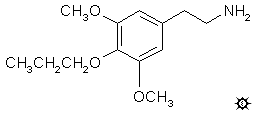
#140 P
PROSCALINE; 3,5-DIMETHOXY-4-(n)-PROPOXYPHENETHYLAMINE
|
| [3D .mol structure] |
A solution of 4.7 g 3,5-dimethoxy-4-(n)-propoxyphenylacetonitrile in 20 mL THF was treated with 2.4 g powdered sodium borohydride. To this well-stirred suspension there was added, dropwise, 1.5 mL trifluoroacetic acid. There was a vigorous gas evolution from the exothermic reaction. Stirring was continued for 1 h, then all was poured into 300 mL H2O. This was acidified cautiously with dilute H2SO4, and washed with 2x75 mL CH2Cl2. The aqueous phase was made basic with dilute NaOH, extracted with 2x75 mL CH2Cl2, the extracts pooled, and the solvent removed under vacuum. The residue was distilled at 115-125 °C at 0.3 mm/Hg to give 1.5 mL of a colorless oil which upon dissolving in 5 mL IPA, neutralizing with 27 drops concentrated HCl, and dilution with 25 mL anhydrous Et2O yielded 1.5 g 3,5-dimethoxy-4-(n)-propoxyphenethylamine hydrochloride (P) as spectacular white crystals. The catalytic hydrogenation process for reducing the nitrile (see under E) also succeeded with this material. The mp was 170-172 °C. Anal. (C13H22ClNO3) C,H,N.
DOSAGE: 30 - 60 mg.
DURATION: 8 - 12 h.
QUALITATIVE COMMENTS: (with 30 mg) Proscaline dulled my sense of pain and made the other senses really sharp. Everything felt really soft, and clean and clear. I could feel every hair my hand was touching. I felt so relaxed and at ease. I know that under the appropriate circumstances, this material would lead to uninhibited eroticism.
(with 35 mg) The whole experiment was very quiet. There was no nystagmus, no anorexia, and insignificant visuals with the eyes closed. I was restless with a bit of tremor for the first couple of hours, and then became drowsy. Would I do this again? Probably not. It doesn't seem to offer anything except speculation about the nature of the high. The high was pleasant, but quite uneventful.
(with 40 mg) For me there was a deep feeling of peace and contentment. The euphoria grows in intensity for several hours and remains for the rest of the day making this one of the most enjoyable experiences I have ever had. It was marvel-ous talking and joking with the others. However, I was a little disappointed that there was no enhanced clarity and no deep realizations. There was not a problem to be found. There were no motivations to discuss anything serious. If I had any objection, it would be with the name, not the pharmacology.
(with 60 mg) The development of the intoxication was complete in a couple of hours. I feel that there is more physical effect than mental, in that there is considerable irritability. This should probably be the maximum dose. Despite feeling quite drunk, my thinking seems straight. The effects were already waning by the fifth hour, but sleep was not possible until after the twelth hour. There was no hangover the next day.
EXTENSIONS AND COMMENTARY: There is a very early report describing the human use of proscaline tucked away in the Czechoslovakian literature that describes experiments at up to 80 milligrams. At these dosages, there were reported some difficulty with dreams, and the residual effects were still apparent even after 12 hours.
The amphetamine homologue of proscaline, 3,5-dimethoxy-4-(n)-propoxy-amphetamine is an unexplored compound. Its synthesis could not be achieved in parallel to the description given for P. Rather, the propylation of syringaldehyde to give 3,5-dimethoxy-4-(n)-propoxybenzaldehyde, followed by coupling with nitroethane and the reduction of the formed nitrostyrene with lithium aluminum hydride would be the logical process. Following the reasoning given under E, the initials for this base would be 3C-P, and I would guess it would be active, and a psychedelic, in the 20 to 40 milligram range.
| [ |
[Main Index] | [Forward |

